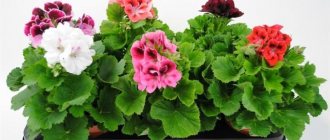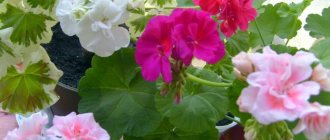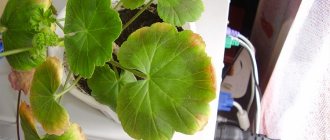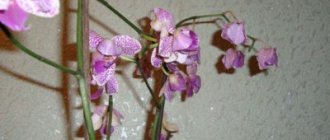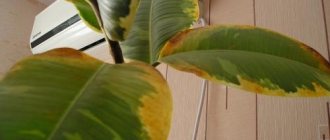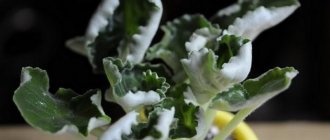One of the most attractive, but also quite finicky flowers is the domestic rose, whose leaves turn yellow and fall off for many reasons. First of all, this is due to violation of the rules for caring for a striking representative of the flora. In order for the plant to remain attractive, you need to constantly take care of it, water it, fertilize it, and provide access to fresh air. Otherwise, the rose will stop developing, and you will also have to forget about flowering. A weakened plant becomes susceptible to viral and fungal diseases that can lead to its death.
Pests
Sometimes the leaves of indoor roses slightly change color to a lighter shade, which many confuse with yellowness.
At the same time, the old leaf plates begin to wither, and the young ones grow deformed and pale. This indicates the presence of pests in the root system area. Carefully move the soil away from the base of the trunk and a little deeper. This is where harmful larvae or worms live. Some sources recommend catching parasites with tweezers. Give it a try. And it’s good if there was only one worm. What if the soil was more contaminated? Are you going to use tweezers all over the pot? During this time, the indoor rose will simply bend.
Don't rely on your sleight of hand, it may not be enough. Use any broad-spectrum or long-lasting systemic insecticide. Be sure to repeat the soil treatment in a month.
Advice. Be sure to replant your indoor rose from store-bought soil into your own. But only after disinfection by freezing or heating in the oven.
Dangerous pests
Aphids, thrips and spider mites are the most common pests of house plants, due to which they often get sick and dry out. They are easy to spot. Usually both the insects themselves and traces of their activity are visible. The presence of parasites is indicated by gnawed areas of indoor rose leaves and small dark spots on them. The presence of a tick will be revealed by a spider web, which is usually located under the foliage. If such signs are found, it means that the flowers wither for this very reason.
All affected parts of the plant are carefully removed. Then treatment is carried out with special solutions against insects.
It is recommended to do this as a preventive measure in the summer, even if the pests are not visible.
Preventing the problem from recurring
- Water only with slightly warm and settled water. In winter, it is recommended to warm up the liquid a little (read about how to generally care for roses in winter here).
- Rosa has a positive attitude towards bathing and spraying.
- Damage to the roots very often provokes leaf fall, so you need to be careful and careful when replanting.
- If a spider mite is found on the plant, the indoor rose is placed in quarantine, where it will remain until complete recovery.
Also, in order for an indoor rose to grow well, it is important to know the rules for pruning it and the procedure for urgent help if problems arise.
Causes of yellowing leaves of indoor roses
The reasons for yellowing of leaves can be very diverse, for example, sunburn. The fact is that direct sunlight is destructive, not only for the leaves of an indoor rose, but also for its flowers. It is best to keep this plant near windows that are directed to the southwest or southeast.
But there are several other possible reasons why the leaves of an indoor rose begin to turn yellow:
- watering the plant with too cold water;
- overdried substrate;
- draft;
- overflow
For normal functioning, indoor roses simply need fresh air. In this regard, in the summer it is best to keep it either on the balcony or on the terrace. You can also take a flowerpot with a rose to a flowerbed and bury it a little in the ground. If you live in an apartment and you don’t have this opportunity, you can keep the rose just next to an open window, while avoiding drafts. Thanks to such manipulations, an indoor rose can easily withstand even the strongest sun.
We present to your attention several possible reasons for the change in leaf color of indoor roses:
- if your indoor beauty does not have any pests and is not sick with anything, but its leaves still turn yellow, this may indicate that the plant lacks some nutrients;
- if the leaves of an indoor rose become pale green and turn yellow from the midrib, this directly indicates a lack of nitrogen;
- yellowed leaves with spots are evidence of potassium deficiency. And if yellowing is visible between the veins of the foliage, it means the plant lacks iron;
- Interestingly, rose leaves can turn yellow even if the plant receives too many nutrients. In order to prevent this, it is necessary to adhere to the correct dosage of fertilizer, which is indicated on the package;
- The plant should be fertilized on time, especially during the flowering period. The fact is that at this time the rose is greatly depleted and requires additional nutrition. If this is not done, the leaves of the plant will be yellow and limp, and the number of flowers will be insufficient;
- Another cause of yellow leaves may be chlorosis. The main signs of its presence are yellowing of the leaves, but with green veins, as well as yellow spots on green leaves. In order to combat this disease, as well as to prevent the disease, you should use a water-soluble iron chelate fertilizer. They need to not only water the plant, but also spray it.
Remember that another reason for yellowing of the leaves of an indoor rose may be its improper replanting. This plant must be replanted once a year, preferably in February
This is done by transshipment, but with extreme caution so as not to damage the roots of the plant in any way. An already transplanted plant should be moved to a warmer place.
By the way, when replanting a plant, it is necessary to change not only the soil, but also the pot. Every year its diameter should increase by 2-3 centimeters.
Reason 1. Nitrogen starvation
One of the most common causes of yellowing rose leaves is nitrogen deficiency.
Yellowing due to nitrogen deficiency occurs first on older leaves
Being a perennial crop, during their life roses remove a large amount of nutrients from the soil. If you do not replenish them, after a few years the bushes will begin to starve.
The following signs indicate a lack of nitrogen:
- the lower old leaves turn yellow and may fall off;
- young upper leaves become smaller, acquire a pale color with dark dots, leaf blades become narrow;
- there are few buds, the flowers are formed small, their color is paler than usual;
- growths are weak and thin.
If roses exhibit this set of symptoms, they must be fed with one of the nitrogen-containing compounds:
| Compound | Feeding method |
| "Fertika for roses" | Dissolve 40 g in 10 liters of water and water the bushes |
| Ammonium nitrate | Dissolve 1 tablespoon in 10 liters of water and water the bushes |
| "Pokon Roses" | Sprinkle the granules evenly in the tree trunk circle at the rate of 1.5 measuring spoons per 1 m2. Plant shallowly into the soil and water the bush. |
| "Gloria for Roses" | Dilute 2 caps in 1 liter of water and feed the bush leaf by leaf. |
In addition to mineral and organomineral fertilizing, the lack of nitrogen can be compensated for by adding organic matter - manure humus, mullein or chicken manure infusion. But it must be remembered that nitrogen overfeeding is no less dangerous for roses than starvation. You need to feed the bushes with nitrogen only at the beginning of the growing season, when shoots are actively growing.
Diseases that cause yellowing of roses
One of the common diseases of indoor roses is powdery mildew. Leaves, stems and buds are affected by fungi. First, a light fluffy coating appears, then it begins to darken, and brown spots form. The leaves turn yellow, become deformed, and curl. If you do not immediately react and treat the plant, it will die. At best, its growth will stop, the foliage will fall off, and the flowers will lose their petals. The rose will lose its attractive appearance.
All affected parts of the plant will have to be removed, otherwise it will not be possible to defeat the disease. It spreads rapidly and also easily spreads to neighboring flowers. Spores are carried on the hands after working with an injured representative of the flora, and easily move through the air.
Note! At the early stage of the disease, when the leaves seem to be sprinkled with flour, and the plaque is wiped off with your fingers, you can use a solution of soda with added soap. If the plant does not recover, it is better to resort to fungicides
Black spots may appear on the leaves of indoor roses. They have jagged edges and are clearly visible. At the same time, the leaf blades themselves turn pale, turn yellow, and wither. Over time, the spots grow and merge, and may appear on shoots. Plant growth slows down and flowering does not occur. The affected leaves fall off, new shoots are formed, which do not have time to gain strength and immediately encounter the disease. A systemic fungicide will help cope with it. The substance penetrates the plant and promotes its recovery.
If yellow-red spots are noticeable on the rose, then rust has appeared. The main reasons are high temperature at home and stale air when the room is rarely ventilated.
Rust appears due to stuffiness
Fungal infections
Fungal diseases are difficult to diagnose. When spots are found on the leaves, it is most likely spotting. If your fears are justified and you do not take the necessary measures, then you can say goodbye to the flower.
The disease is contagious and contact with other plants will lead to their infection too. The fungus spreads and affects weaker representatives of the flora, to which the rose belongs primarily. The leaves will gradually dry out and gradually disappear altogether.
If negative signs are detected on the bush, you must urgently remove the affected leaves and treat the bushes, incl. and healthy, copper-containing preparations.
You should not spray the bush with water during illness to prevent the infection from spreading further. It is important to provide quarantine for this bush, without contact with other plantings.
Improper watering
If you water your flowers incorrectly, you can seriously harm them. Cold water should not be used to water roses. As a result, the bush becomes sick, stops growing and dies over time. The water should be soft and settled. Some gardeners advise boiling it.
The frequency of watering can be selected according to the condition of the soil in the pot. If its top layer begins to crack, moisturizing is necessary. Mature plants are watered two or three times a week. In the summer heat, you can water them more often and install a humidifier in the room.
The foliage of indoor roses often turns yellow due to improper watering of the plant. This can be either overwatering or insufficient watering. Overdrying of the flower, in addition to its yellowing and loss of leaves, may also be indicated by a general depressed appearance and the appearance of cracks in the soil. If overwatering occurs, the symptoms will be somewhat different: yellowing of the foliage in this case is accompanied by lethargy of the plant, its wilting, and the presence of a “swamp” in the pot.
Why does a rose dry in the garden? 4 Mulching and watering a rose bush
Cover the area with mulch around the bush with a layer of 2.5–5 centimeters. Buy organic or non-organic mulch online or at a home or gardening store. Spread the mulch around the rose bush in one even layer. Leave 2.5 centimeters of empty space around the base of the bush.
- Do not spread mulch around the crown of the bush.
- Mulch will allow the soil to retain more moisture to feed the roots and prevent weed growth.
- Organic mulch includes wood chips, straw, freshly cut grass and leaves.
- Inorganic mulches include gravel, rocks and glass.
- Replace or add more organic mulch once a year in early summer.
Spread cardboard mulch if you're having trouble controlling weeds. This mulch will help get rid of weeds. Spread it on the selected area of soil in a dense layer. It will cover the weed seeds from the sun's rays and thereby prevent them from germinating.
Water your rose bush when the soil is dry. It is necessary to thoroughly moisten the soil if it does not rain in your area every week or the rose bush acts as a houseplant in a pot. The top 5–8 centimeters of soil should be moist. You can test the soil by running your finger through the top layer. Add water if it is dry.
- Roses will dry out if they are not watered regularly.
Water your rose bush before sunrise and after sunset. If you do this in the middle of the day, when it is sunny outside, then they will remain stained from dried drops of water. In addition, the water will evaporate quickly and will not sufficiently moisten the soil.
Why do rose leaves turn yellow?
Most often, yellowing of foliage is caused by the following reasons:
- Lack of mineral fertilizers. Depending on what the plant lacks, it turns yellow in different ways. When a crop needs nitrogen feeding, it turns yellow completely, starting from the lower leaves. Application of universal fertilizers or urea can help. If a rose lacks iron, it begins to turn yellow in spots - from top to bottom. In this case, any acidifying fertilizer will do.
- Excess feeding. Excess mineral fertilizers can also lead to leaf fall. When the flower is weakened and you want to feed it, it is better to start with half the dose, otherwise you can burn the roots.
- Pests and diseases. One of the most common diseases is chlorosis. You can fight it with the help of Antichlorosin, which dissolves well in water. The plant is watered with it twice during the growth period, and then once every two weeks, if necessary.
- Excessive humidity. Although roses love moisture, excess is harmful to it, otherwise it will begin not only to turn yellow, but also to rot. Finding a middle ground is not difficult - it is enough to provide good drainage and water the plant as soon as the top layer begins to dry out. In addition, it is useful to spray it with warm water from a spray bottle.
Mineral deficiency
Let's say you protect your rose bushes well from diseases and pests, and there are no problems with watering. However, something still went wrong, and now your flowers are again suffering from yellowing leaves, and the overall appearance of the plant has deteriorated significantly. In this case, one key conclusion suggests itself: the rose suffers from unbalanced feeding. Moreover, the reason for this may be either the oversaturation of the soil with minerals or their deficiency. In order for your plants to develop fully, the following mineral elements must be present in moderate quantities in the soil composition:
- nitrogen. When a rose lacks nitrogen, it becomes faded and withers much earlier than expected. This mineral component is added to the soil so that the plant grows and develops intensively. If your fragrant roses are covered in yellow spots, add some nitrogen to the substrate to improve the aesthetics of the plant;
- phosphorus. When a rose does not receive enough phosphorus, not only its leaves turn yellow, but also its root system. The condition of the plant gradually deteriorates until the rose withers completely. However, fertilizers containing phosphorus must be applied carefully. In this way, you will improve the appearance of the plant, but its shoots will not become woody;
- potassium. For the most part, this element promotes active flowering, however, with its prolonged deficiency, the appearance of brown and yellow spots is quite possible;
- iron. If you do not feed garden roses with iron, the appearance of a disease called chlorosis is not far away.
Every gardener wants the roses he planted in his garden to delight him with their bright and long-lasting flowering. However, white and yellow spots sometimes spoil the overall picture. Find out the cause of this disease and then do everything necessary to save the rose bushes from death. That is why you need to act decisively and quickly.
What to do if your houseplant drops its leaves?
There are several reasons why this whimsical plant sheds its leaves and dries up:
- Physiological aging is when a flower, at the final stage of its life, begins to shed its leaves and buds.
- Seasonality - when an indoor flower sheds its leaves in the fall so that new ones grow in the spring.
- Violation of the light regime - lack or excess of sunlight.
- A change in weather or a change in the microclimate of the house - a change in air temperature and humidity level in the room, the appearance of a draft or the start of heating devices in the house affect the condition of the rose.
- Violation of the irrigation regime - lack or excess of moisture in the soil.
- Presence of pests – parasites dangerous to flowers, especially spider mites, can destroy a plant in a matter of days.
- Unsuitable soil - a lack or excess of nutrients in the soil leads to the fact that the flower begins to hurt and wither.
- The rose is damaged by pathogenic microflora - the flower begins to rot or black spots appear on it.
- Carefully examine the flower. If the leaves turn yellow and fall off on one side, this may indicate an excess of sunlight. In such a situation, it is necessary to provide the rose with diffused light.
- Check the soil in the pot. If the pot has cracked, dry soil, you need to start watering it regularly. For irrigation, use pre-settled water at room temperature.
- Remember the last time the soil of the rose was changed. If it was more than a year ago, then it is advisable to urgently start feeding the plant. But you should carefully study the instructions and strictly follow them so as not to overfeed.
- Check leaves and stems. If pests are detected, it is recommended not to delay the start of treatment. In this case it is necessary:
- Isolate the rose from other plants.
- Use a sterile blade to trim off all affected areas.
- Treat with parasite repellent according to instructions.
If a rose drops all its leaves in the shortest possible time in spring or summer, this means that:
- The flower is located in a room with very dry air. What to do in a situation if the plant has dropped all its leaves:
- Move it to another room or install a humidifier nearby.
- Water the flower regularly and do not allow the soil to dry out.
The flower was infected with a dangerous disease. In this situation, the action plan is as follows:
- Trim off all affected areas of the flower and remaining buds with a sterile blade.
- Treat the plant with special means.
A rose that has dropped all its leaves will take a long time to recover, so it is recommended to be patient and wait, while observing the light and watering regime.
Treatment and prevention
What to do if the leaves of your home rose turn yellow and fall off:
- To get rid of parasites that deprive plants of their strength and take away nutrients, you need to treat the leaves and stems with fungicides. They will also help cure powdery mildew and black spot. It is preferable to use drugs that have a systemic effect. Before the procedure, you need to get rid of the affected parts of the plant to speed up recovery;
- care must be taken to ensure that the rose is not exposed to the scorching rays of the sun and is protected from the cold wind. Dry air in the room is detrimental to the plant, so you will have to do additional humidification. In summer, it is recommended to spray the leaves daily, especially if the rose remains indoors and does not move to the balcony. You can place glasses or bowls of water on the windowsill so that it gradually evaporates, humidifying the air;
- excess or lack of fertilizer is adjusted depending on the symptoms of the disease and soil characteristics. It must be remembered that any feeding should be stopped when the rose is weakened. This concerns infection with various fungal diseases and the destructive effects of parasites. Once the flower has recovered, you can return to using fertilizers.
Healthy indoor roses will reward you with lush blooms
Flower growers, especially beginners, do not always immediately understand why the leaves of indoor roses turn yellow. They forget that they need to think not only about timely watering and fertilizing, it is important to maintain high humidity and ventilate the room daily. Yellowing and falling leaves occur in a weakened plant, the rules of care for which are not followed. The rose is capricious, but if you pay enough attention to it and follow all the recommendations, it will delight you with abundant flowering, which usually begins in June and continues until November.
How to save an indoor rose after purchase
The rose is a difficult flower to keep at home; it is quite demanding and capricious. It is not enough to become the happy owner of this beauty, you also need to preserve the flower and find an approach to it, otherwise sad consequences will not keep you waiting.
Yes exactly. The purchased plant usually looks fresh and full of vigor, blooms amazingly and it seems that it will always be like that.
In fact, the plants arrive on the counter fed with all kinds of stimulants; in addition, they have special packaging that retains high humidity. Once on our windowsill, roses are deprived of all this.
Almost immediately, inexperienced gardeners have problems: the roses begin to turn yellow, their leaves dry out and fly off, the buds fall off and turn black. Rosette orders to live long and disappears, leaving behind nothing but frustration.
It should be noted that the rose is considered an open ground plant. Some varieties are more suitable for indoor use than others. But this does not mean that keeping them in an apartment is an easy matter.
So, what steps should you take when you bring a rose home:
Remove the packaging wrapper, if any. Although the packaging helps to retain moisture, it often causes the rose to become infected with fungal diseases while still in the store, because... packaging interferes with air exchange, creating an ideal environment for fungi. Use pruning shears or scissors to remove all wilted leaves, blackened and dried stems that are on the plant. Flowers and buds also need to be trimmed. Of course, for the sake of them we buy a plant and we would like to admire them to our heart’s content, but the plant, the flowering of which was stimulated by special preparations and greenhouse care, subsequently simply cannot withstand such abundant flowering, and, having given all its strength to it, dies
Therefore, we cut off all the flowers and buds that are present on the plant, along with the supporting stem. Pay attention to the number of bushes in the pot. Growers of indoor roses often plant several plants in one pot to create the appearance of a lush flowering bush.
Crowded plants weaken each other and there is a lack of nutrients. Bushes, if there are several of them, must be planted in different pots.
After transplantation, it is necessary to treat the rose with antifungal drugs (Fitosporin) and pest control drugs (Fitoverm).
What is abscission and what does it look like?
Often, leaves that lack chlorophyll fall off . The leaves become wilted and eventually dry out completely. Rose buds may also fall off.
Important! You need to know that falling off can be either a natural process or caused by various diseases or improper maintenance of the plant.
The first sign is that the leaves have turned yellow. The appearance becomes unaesthetic, the indoor rose looks sick. Then the real leaf fall begins. Sometimes all the leaves fall off completely.
Caring for an indoor rose after purchase - how to preserve a flower
The indoor rose is a very delicate flower and capricious to environmental conditions, so you should take care of this beauty from the first days of its acquisition. The fact is that in flower shops, roses in pots are fed with special preparations, thanks to which they maintain their ideal appearance; in addition, the packaging of the plant helps maintain the required humidity level.
- Remove the cellophane packaging - in apartment conditions it will not maintain the required level of humidity, but will cause poor air circulation and the appearance of pathogenic bacteria and fungus;
- Cut off all non-living leaves and stems with sharp scissors; the same should be done with leaves that have defects - spots, dried tips;
- Remove flowers and growing buds, no matter how sorry it is - if you give all the emerging buds the opportunity to bloom, the rose will lose all its strength and die;
- Plant a rose if several bushes are planted in one small pot (as a rule, in stores they do this to give the flower a lush shape) - this way there will be enough nutrients in the soil for each bush;
- Treat your home rose with drugs against fungus and parasites (Fitosporin, Fitoverm).
Replanting an indoor rose after purchase is necessary if the pot is too small for it - in this case, the flower is carefully removed from the old flower garden along with the soil, the brown and black roots are removed (the healthy color of rose roots is white), rotten parts, then the plant is placed in a new pot with properly selected soil. The soil for roses can be prepared independently; for this you will need:
- Compost;
- Leaf humus;
- Soil from under coniferous trees;
- Turf soil;
- Clean sand.
The listed components are mixed in a ratio of 1:1:1:3:1, the soil mixture is poured into the flower garden on top of the drainage. The rose is placed in a new pot along with an old lump of earth, firmly fixed and watered with warm water. It is recommended to treat the newly transplanted plant with a drug to enhance immunity - Epin is ideal.
Pests and feeding
Rose, like many other indoor plants, is very afraid of spider mites. Determining the presence of such a pest is quite simple. The leaves begin to fall and small bugs can be seen climbing on them. If you turn the leaf over, you can see a characteristic white coating on its back side. To solve this problem, you need to use special preparations that are sold in flower shops. Spraying the flowerpot is carried out according to the instructions on the product packaging.
Roses are quite capricious and demanding plants. For normal flowerpot growth you will need a sufficient amount of minerals and trace elements. A lack of any element will negatively affect the plant. So, if a flower lacks magnesium, its leaves begin to fall off over time. In the case of a lack of nitrogen, they stop growing and change their color. To prevent such changes, it is necessary to feed the plant in a timely manner. To do this, it is worth using special fertilizers designed specifically for flowering flowerpots.
A common cause of discoloration and falling leaves is excessive flowering. The development of buds and flowering takes quite a lot of effort. When there is a lot of color, the leaves become defenseless and are easily susceptible to diseases, pests and various changes. This problem is solved with the help of special fertilizers and preparations that are sprayed on the flowerpot. With their help, you can strengthen the flower’s immunity and supply it with all the microelements and minerals for full growth and development. All medications must be used in accordance with the instructions.
Insufficient or excessive feeding
The soil must contain sufficient nutrients for normal flower growth. For flowering and growth, regular feeding is necessary. Insufficient calcium and iron content in the soil affects the leaves. This is another reason why Chinese rose leaves turn yellow. An indoor rose is most likely lacking iron and calcium if yellowness appears directly between the veins.
In particular, a lack of nitrogen can occur during active flowering . This may also be the reason why the rose drops its leaves. What to do? Be sure to fertilize the plant a week after transplantation, as well as every three weeks. It is better to purchase a complex fertilizer intended specifically for roses.
But excessive oversaturation of soil minerals can harm the flower. Powdery mildew is a signal that you should wait a bit with fertilizers. The disease looks like a white coating on the leaves. Treating surviving leaves and shoots with a fungicide will help; diseased shoots should be removed.
Traditional methods to promote good rose growth:
- Infuse 170 grams of garlic in 1 liter of water for 5 days. Then add a solution to the water for irrigation in the proportion of 1 teaspoon per 1 liter;
- dry mustard powder;
- ash.
When purchasing a flower, be sure to check its variety. There are deciduous types of roses that, in preparation for winter, shed their leaves and retire from October to February. There is another problem that the plant may encounter - a virus. If a virus has infected your pet, then it is unlikely that you will be able to help the flower survive. A cure for this problem has not yet been found. If all care recommendations are followed, this magnificent fragrant flower will delight the eye of its owner for a very long time!
Yellowing of roses due to lack of nutrients in the soil
The beginning of yellowing or falling leaves can be explained by a lack of useful elements in the soil. The most important substances that influence the development of culture include the following:
Iron
Why do rose leaves turn yellow outside in summer?
A deficiency of this substance provokes the development of chlorosis. With this disease, the foliage becomes yellow, decreases in size and curls.
To cope with the problem, it is worth using products such as Ferrilene, Ferovit. The ampoule of the composition must be mixed with water and sprinkled on the plants.
Nitrogen
This product is responsible for the condition of the green mass. A deficiency of the element provokes blanching of the foliage and its gradual yellowing.
Roses have a special need for the element in the spring. In this case, you need to add ammonium nitrate. It is also permissible to use a combined composition.
For reference! It is worth considering that excess nitrogen can cause fungal pathologies, which negatively affects the condition of the bushes.
Potassium
If there is a lack of this element, the edges of the leaves dry out in the plant. At the same time, the veins remain green. After a certain time, the leaf blades turn completely yellow and turn red-violet.
The rose should be fed with potassium magnesia. A large amount of potassium provokes developmental delays.
Manganese
Affected foliage acquires a yellow tint between the veins - from the edges to the central part. A green border appears around the veins. In this case, only old leaves turn yellow. The rose needs to be fertilized with manganese sulfate and the soil deoxidized. You can add peat to it. Ammonium sulfate will also work.
Magnesium
If there is not enough of this substance, dark red spots appear between the veins. The edges of the leaves remain green. At the same time, they are observed to fall off.
To avoid such problems, you need to regularly add ash to the soil. Magnesium sulfate will also work. In this case, the increased content of the substance provokes a violation of the absorption of potassium.
Insufficient application of fertilizers provokes the appearance of a yellow border on the foliage.
Problems with fertilizers
Spots on the leaves appear both due to a lack of nutrients and their excess in the soil
In the process of growing roses, pay special attention to the period at which it is recommended to apply certain fertilizers, when the plant is more in need of certain nutrients, and when in others. Awareness in such moments can be a salvation for your favorite rose.
Among the elements that must be present in a garden rose are the following:
- nitrogen. Intensive growth, as a rule, is impossible without adding this substance to the soil. If there is a lack of it in the soil, the plant becomes faded and generally fades much earlier. In addition, if the rose turns yellow, there is a high probability that it was caused by nitrogen deficiency. Take care of feeding the flower with nitrogen, otherwise you can forget about the decorativeness of the bush and the long periods of its flowering;
- phosphorus. In the absence of this element in the soil or its presence, but in small quantities, not only the above-ground part of the plant suffers, but also the rhizome. The leaves of the rose are actively turning yellow, and soon they will simply fall off. But it is also undesirable to overdo it with phosphorus fertilizing - if there is an excess of the element in the substrate, the rose may become woody;
- potassium. If phosphorus and nitrogen have a much greater influence on the development of stems and leaves, then potassium affects the duration and intensity of flowering. If you want flower buds to be large, bright and not fade too quickly, you cannot do without feeding your roses with potassium. However, the absence of this element in the soil is fraught not only with faded and small inflorescences. Brown and yellow spots on the leaves are what else you will have to deal with;
- iron. Yellow spots on rose leaves may indicate chlorosis. This disease occurs if the plant is not saturated with iron in sufficient quantities.
To prevent the plant from turning completely yellow, it’s time to think about feeding it.
Detrimental factors affecting flower development
First you need to figure out why the leaves of an indoor rose turn yellow. Often, to solve this problem, it is enough to move the pot to another place where there is no direct exposure to sunlight - then the condition of the flower will normalize. But it happens that the reasons for yellowing of leaves lie in other unfavorable conditions for the development of the plant.
Unfavorable factors for roses
If you water with too cold water, you should water with water at room temperature. Drafts - it is recommended not to keep the plant under an open window. Abundant or, on the contrary, rare watering - the rose requires optimal moisture content in the soil. Lack of fresh air - in summer you need to take the pot out onto the balcony or terrace. Lack of nutrients - roses definitely require regular feeding. Incorrect replanting - if you need to move the plant into a large container, this should be done with the utmost care, and the month chosen for such actions is February. In this case, the rose has a better chance of taking root. Powdery mildew is a white coating that appears when there is excessive application of fertilizers or lack of fresh air. Rust – appears in the form of bumps
The reasons for its appearance are abundant watering and high room temperature. Thrips - appears at low humidity, it gives the leaves a gray-yellow color. Spider mites are caused by too dry air or insufficient space for plants.
Transplanting an indoor rose
To replant a rose, remove it from the previous pot along with the earthen lump. Assess the condition of the roots entwined in the ground.
If the roots are hair-thin, brown or blackened, dry or rotten, the plant will most likely die. You can try to save it: cut cuttings and try to root them.
Healthy roots are bright white or yellowish in color and look quite dense, like a thin wire. If the roots are only partially missing, you need to remove all the rotten and damaged ones, leaving the healthy ones.
Place expanded clay or other drainage at the bottom of the new pot.
It is better to purchase a soil mixture ready for roses or a garden mixture. Do not use cheap soil; it contains a lot of peat and few nutrients. It is better to choose a higher quality soil mixture.
Fill the drainage with soil and compact it a little. Place the rose bush together with a lump of earth, cover it with new soil, periodically compacting it so that the bush does not dangle in the pot, but is well fixed. Water with settled or filtered water at room temperature.
Treatment against diseases and pests is necessary. A pruned and replanted plant is weakened and susceptible to disease, even if it was well cared for at the store and no infection occurred. Therefore, it is better to play it safe and process it.
Also, after transplantation, treatment with Epin is effective - it will strengthen the plant’s immunity and reduce stress from transplantation.
Spray your plant; it requires high humidity, especially in conditions of operating heating and dry air in the apartment. If the rose is very small and weak, then the pot can be covered with a bottle (with small holes) on top, creating a greenhouse, and only then gradually accustom the rose to apartment air.
Next, we place the pot with the transplanted plant in a well-lit place. If you have a shady side and there is not enough light in winter, illuminate the rose with fluorescent lamps.
Incorrect pot or soil for transplantation
Roses should be replanted in neutral soil. You can buy it in specialized stores that sell special soil for roses. Using an acidic or alkaline substrate will cause the foliage to turn yellow.
You should also choose the pot carefully. The new container should be only 2-3 cm larger than the old one. Drainage must be poured into the bottom of the pot.
Transplantation is carried out using the transshipment method so that the plant undergoes the procedure painlessly.
After transplanting, the flower should stand in the shade for two or three days.


